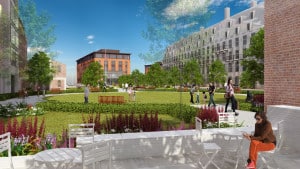
JW Capital Partners wants to build a 277-room luxury hotel on pilings over Boston Harbor at the end of Lewis Wharf in the North End.
Vocal opposition to development is part of the drill in Boston’s North End, a neighborhood with a history of fiercely defending its residential and historic character.
Now developers can add climate change to the list of hurdles when attempting to build near Boston Harbor. A proposal to build a 277-room luxury hotel on Lewis Wharf has unleashed a flood of opposition from neighbors, cultural institutions, state and local politicians and environmental groups.
The development is a potential bellwether of how regulators treat waterfront development in the post-Hurricane Sandy era. Only 2.4 acres of the 9-acre site are located on land, with the bulk of the hotel designed to be built on pilings over Boston Harbor.
“This is a big test,” said Peter Shelley, senior counsel at the Conservation Law Foundation of Massachusetts. “It’s going to be one of the city’s first and most important tests of whether it is going to seriously confront the implications of increased storm activity and sea level rise.”
Will Adams, a principal for development team JW Capital, says the developers have no plans to substantially change designs for the 187,000-square-foot hotel despite a wide range of objections. The developers last year abandoned plans to include condos in the project, conceding that they would not be allowed under state Chapter 91 regulations that safeguard public access to the waterfront.
“We’re going to look at an alternative analysis, but the project we’ve conceived we feel is fully compliant with Chapter 91,” Adams said. “All the other projects on the water were developed in (flood) zones.”
State Official Waves Red Flags
While development booms across Boston and proposals for new skyscrapers and mixed-use complexes sail through the approval process, shoreline development answers to a higher set of standards. In addition to city approvals, projects built on waterfront parcels have to provide public access and allow water-dependent uses under a legal doctrine that dates back to Colonial days.
Environmental advocates say state regulators have sided with developers while interpreting Chapter 91 standards in the past. Growing concerns about climate resiliency could change the rules of the game.
“MEPA and the city are likely to push hard on an alternative design,” said attorney Ron Ruth, co-chair of the environmental practice at Sherin and Lodgen LLP in Boston. “Ever since (Hurricane) Sandy, the regulators have had to focus with new attention to urban designs and the concept of substantial inundation from the sea.”
The Lewis Wharf project could offer a guide to how city and state regulators treat other potential major developments on Boston Harbor, including Chiofaro Co.’s proposed 1.3-million-square foot Harbor Towers on East India Row and redevelopment of the James Hook & Co. lobster pound property on Northern Avenue into a 285-foot-tall residential tower.
Matthew Beaton, the state secretary of energy and environmental affairs, raised a series of red flags as he ruled that the Lewis Wharf project requires an environmental impact report (EIR) through the Massachusetts Environmental Policy Act (MEPA). In an Oct. 23 letter, Beaton said the developers must study the site’s vulnerability to flood and storm damage and show that its design can survive future superstorms. He urged developers to consider moving buildings onto the land-based section of the property while shifting open space and parks to the waterfront, where they would buffer the impact of storms and improve public access to the harbor.
That approach would emulate the designs of Clippership Wharf, the 477-unit residential complex being built in East Boston. Developer Lend Lease elevated ground floors three feet above FEMA guidelines and is planting a 7,000-square-foot living shoreline to absorb future flood waters.
That doesn’t appear to be the direction that JW Capital is leaning, however.
During an Oct. 8 site visit, the developers said a floating breakwater could be installed to protect the site from storm surges, according to the Beaton letter. That could open the way for them to petition FEMA to change flood maps and build the hotel at a lower elevation.
Hotel Rooms On Pile Field Challenged
One of the key legal issues in the Lewis Wharf case centers on the deteriorating 1.6-acre wharf and pile field where the hotel would be built on a pair of piers jutting out into the harbor.
Under Chapter 91, new non-water dependent uses such as hotels can’t be built on pilings, but the property has an existing Chapter 91 license for the failing wharf and pile field. Opponents say the license should be revoked because of the advanced deterioration of the structures; the developers say they have a legal right to build over it.
Only 15 of the approximately 355 piles can support a structure, according to a visual survey conducted by ESS Group Inc. on behalf of abutter Pilot House Properties LLC.
“It’s our legal view that the property owner, by failing to maintain the pier and the structures on the pier, has lost the benefit of that license. There’s a substantial question of what their ownership interests are,” CLF’s Shelley said.
In the Oct. 23 letter, Beaton said the developers should prepare a survey of the existing pile field and submit a reduced footprint for the hotel if the area is smaller than that depicted in the initial filing.
Adams is partnering with current property owner Philip DeNormandie of Lewis Wharf Limited Partnership and Winchester construction company owner John Moriarty on the project. JW Capital has one previous development project, The Bradley apartment complex that opened this year in Alexandria, Virginia.
JW Capital and its engineering consultant, Epsilon Assoc., are studying the issues raised by opponents as they prepare to draw up the EIR which will be submitted in mid-2016, Adams said.
Property Rights Vs. Public Access
Chapter 91 regulations that protect open space, views and public access also will factor into the permitting process. A 223-space parking lot on the north side of the property would be replaced with an underground garage, freeing up 2.9 acres of open space on the site including 1.25 acres of parks between the waterfront and Atlantic Avenue.
But opponents say the hotel buildings and a connecting lobby structure would create a 55-foot-tall visual wall between Atlantic Avenue and the harbor on one of the last undeveloped waterfront properties close to downtown. In a comment letter, Boston Harbor Association Executive Director Julie Wormser said the developers should provide “significantly more public benefits” than the current designs for open space.
“Other recent waterfront projects, such as Pier 4 in the Seaport District and Clippership Wharf in East Boston, provide engaging, interesting access to the water,” Wormser wrote.








